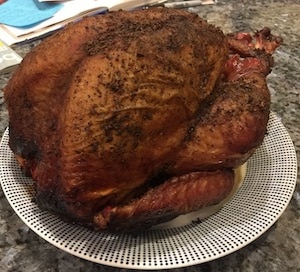
We know the basic food safety guidelines. But sometimes those “basics” are not top of mind when our food prep list keeps getting longer and our time shorter. To ease our minds before, during and especially after our holiday meals, here are five ways to make food safety the centerpiece of your holiday meals.
1. Wash Everything, Except the Turkey!
-
- Wash hands before, during and after food preparations.
- Dry hands on a separate towel (not the one for dishes) or a clean paper towel.
- Wash all fresh fruit and vegetables (whether you eat the skin or not) thoroughly under running water before preparing and/or eating. This includes produce grown at home or bought from a grocery store or farmers’ market. If the produce surface is rough like an avocado or melon, use a vegetable brush to lightly scrub the surface without bruising.
- Don’t rinse your turkey or any poultry! Rinsing your turkey can spread harmful germs and bacteria around the kitchen and increases the risk of cross-contamination.
2. Talking Turkey, Thaw with Thought
-
- An improperly thawed turkey can lead to food poisoning. Using a refrigerator, cold water or microwave are all options but the first two are preferred.
- When using the refrigerator, allow about one day of thawing for each 4 to 5 pounds of turkey. Once a turkey has been thawed, it can remain in the refrigerator for one to two days before cooking.
- When time is not on your side, use the cold-water method. Start with putting your turkey in a leakproof plastic bag before you place it in a water filled sink or container. This keeps the turkey juices from spreading and the turkey from absorbing water. Change the water every 30 minutes and allow about 30 minutes of thawing for each pound of turkey. A turkey must be cooked immediately after thawing in cold water.
- Never thaw a turkey on a kitchen counter! When a turkey stays out at room temperature for more than two hours, its temperature becomes unsafe even if the center is still frozen.
3. Stuff Yourself, Not the Bird
-
- Whether it’s stuffing or dressing, it’s better to keep it in a separate dish than in the turkey.
- But if it’s a tradition to stuff the bird, follow these steps: If using raw meat, poultry or shellfish, cook ingredients before stuffing the turkey. This reduces the risk of foodborne illness from potential bacteria found in raw ingredients. Wet ingredients for stuffing can be prepared ahead of time and refrigerated. Mix wet and dry ingredients together just before spooning the stuffing mixture into the turkey cavity. Immediately place the stuffed, raw turkey in an oven set no lower than 325°F.
- Do not stuff turkeys to be grilled, smoked, fried or microwaved.
- And finally, don’t really stuff yourself with dressing … just enjoy the annual tradition.
4. Take Temperatures
-
- Use thermometers: a meat thermometer and an instant read one!
- For cooking meats, like turkey, a meat thermometer is a must. Whole poultry products, like turkeys, need to be baked to an internal temperature of 165°F to ensure it’s safe. When cooking a whole turkey, check the temperature in at least three places: the innermost part of the thigh, the innermost part of the wing and the thickest part of the breast.
- Use an instant read food thermometer to make sure hot foods are cooked to an internal temperature that kills germs — at least 140°F.
- When it comes to cooking foods, high temperatures are a good thing!
5. Just Chill — The Food and You
-
- Thanksgiving and any holiday celebrations can last for hours but perishable food cannot! Refrigerate perishable food and leftovers within two hours of serving. If the room or outside temperature is above 90°F, refrigerate after one hour.
- Refrigerate leftovers in shallow pans to allow for quick and even cooling.
- Cooling to room temperature on a countertop before chilling is not safe regardless of what you’ve been told.
- Leftovers are to be savored! Eat refrigerated leftovers within 3-4 days or freeze to prevent waste and spoilage. Food items, like turkey, can be frozen for 3-4 months without sacrificing quality.

